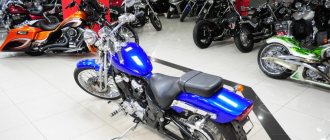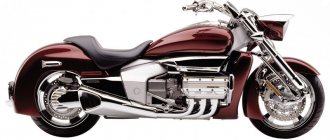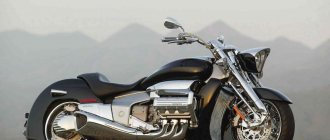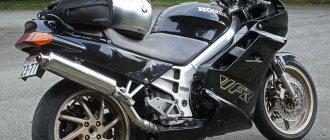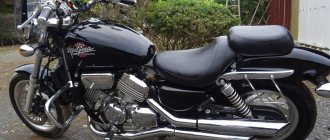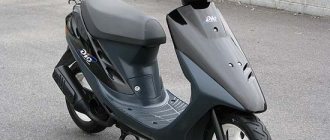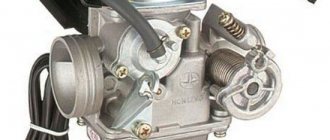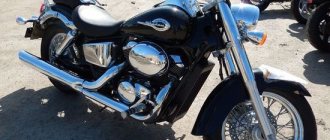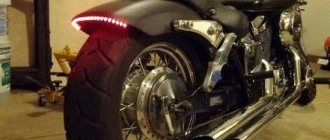By launching the Honda Valkyrie 1800 on the market, the company probably hoped to win the hearts of those who like the technical characteristics of the Gold Wing, but do not like the abundance of plastic. Perhaps the idea would have been a success if it weren’t for the bold and innovative appearance of the bike, which was met with very controversy. The pricing policy also played a role, due to which the price difference between the Valkyrie and a full-fledged Gold Wing was not so great. As a result, the model, which went on sale in 2014, ceased to exist in 2022. However, back in 2004, the small-scale Honda NRX1800 Valkyrie Rune was released in a limited edition, but this is a completely different bike, and we will tell you more about it below.
Specifications
The usual modification (which went into production in 2014) is related to the Honda NRX1800 Valkyrie Rune only by a common ancestor, the GL1800. There are few differences between the Gold Wing and Valkyrie, and in fact the latter is a less expensive trim on the same base. The frame, engine, transmission, most of the chassis - they all have exactly the same.
Engine
The 6-cylinder liquid-cooled injection boxer has excellent performance – 117 hp, 158 Nm of torque . Taking into account the smaller mass compared to the Golda, this is enough for the motorcycle to acquire the dynamics of a rocket with a solid fuel accelerator. If you turn the right handle sharply at a traffic light, the rear wheel is guaranteed to go into a skid, and pieces of asphalt will fly out from under it. The cruiser accelerates from 0 to 100 km/h in 3.4 seconds – an excellent result.
Transmission
The “Gold Wings” of the first years of production were famous for problems with frames and gearboxes, but by the time the Valkyrie went into production they had already been eliminated, so you don’t have to worry about the technical condition of the gearbox. It's just a pity that it doesn't have a sixth gear, it would come in very handy. Although even without it, fuel consumption remains modest for such a powerful and heavy bike, and the maximum speed exceeds 200 km/h .
Chassis and brakes
The cruiser inherited all this from the restyled GL1800 with almost no changes, with the exception of the suspension. The alloy frame helped reduce weight, a 45 mm fork with an anti-dive system Pro-Link swingarm with monoshock at the rear . There are no adjustments, except for preload, but the brakes, without exaggeration, are great! The front wheel has two 310 mm discs with 4-piston calipers, the rear wheel has one 316 mm disc with a 3-piston caliper, and all this is complemented by a combined braking system with ABS . The rear wheel drive, like the Gold Wing, is cardan.
Electronics
Unlike the Golda, both the regular Valkyrie 1800 and the Honda NRX1800 Valkyrie Rune have little electronics. Nothing that could not be found in any other more or less modern motorcycle, but no problems with mandatory computer diagnostics and other innovations.
Weight and dimensions
The length of the cruiser is only a couple of centimeters short of an impressive 2.5 meters, and the width at the extreme points reaches 94 cm. The Honda Valkyrie weighs 1800 as much as 368 kg , but - praise be to the Japanese designers! – all this monstrous mass is not felt. A third of it comes from the engine, located at the very bottom, so even in static conditions, turning the bike is not difficult. You also have to try to drop it, since you will have to tilt it strongly to pass the “point of no return.”
Controllability
Motorcycles like the Honda Valkyrie 1800 are not designed for darting around in city traffic, but for fast (or leisurely, depending on what you prefer) rides along highways. Despite this, the bike steers very well and even predictably. Its considerable size, of course, makes its own adjustments to the control process, but, nevertheless, any experienced pilot can cope with the Valkyrie.
Fuel consumption
Average gasoline consumption is just over 6 liters - an excellent result for such a heavy cruiser. It is recommended to fill it with AI-95, although some owners have been feeding this engine AI-92 for years and say that everything is fine with them. But, as they say, everything here is at your own peril and risk. Taking into account the 23-liter gas tank, the range without refueling is 300-350 km .
Chassis
Characteristics:
- front suspension - reverse telescopic fork, with hydraulic shock absorbers;
- feather diameter - 45 mm, stroke, mm - 98;
- rear suspension - articulated pendulum, travel amplitude 100 mm;
- front brake - ventilated disc, triple caliper, working part diameter 332 mm;
- rear brake - disc, diameter 336 mm, two-piston caliper;
- front wheel size - 150/60R-18″;
- rear wheel, size - 180/55R-17″.
The Honda Valkyrie model, whose characteristics met the requirements of the time, quickly became the most popular in the class of cruise choppers. The prestige of the motorcycle meant a lot.
Motorcycle price
The Honda NRX1800 Valkyrie Rune is rarely found on sale, and its price is not affected by the secondary market - it costs exactly as much as the seller wants, so any options are possible here. As for the regular Honda Valkyrie, used copies start at about 700-750 thousand rubles , and the price of the most recent ones approaches the 1.2 million .
Norse mythology
The motorcycle debuted in early 2014 and was first introduced in the United States, for which market it was primarily intended. The latest generation Honda F6C is radically different from the classic cruiser that bore the formidable name Valkyrie in the 90s of the last century - here the device is of a fundamentally different type, and with some reservations, the new Honda product can be classified as a power cruiser.
The concept of the car is simple and clear: the same magnificent 1832 cc 6-cylinder boxer engine as the Gold Wing, the same chassis almost unchanged, but no sybaritism in the form of sweeping trunks, a music system, GPS navigation and soporific comfortable seats . This means the weight of the motorcycle is significantly less: the new F6C weighs almost 70 kg less than the GL1800 tourer!
Which, with the same power plant, radically changes the power-to-weight ratio and ultimately affects the driving performance of the vehicle. Simple arithmetic! However, motorcycle design is definitely not an exact science. To my taste, the Honda F6C Valkyrie has some kind of irrationally attractive appearance: wrong (so to speak), largely disproportionate and disharmonious, but attractive.
The thin 19-inch front wheel looks rather strange, which does not at all match the massive front part of the motorcycle and its “muscular body”. The huge “ears” of the side plastic covering the radiators of the engine liquid cooling system located on the right and left of the F6C also do not add to the charm of the model...
In general, it is not at all as beautiful as the NRX1800 Valkyrie Rune. Although there is much more from the “Rune” than from the classic “Valkyries”: a cantilevered pendulum of the rear suspension, a deep rear wing, a low and elongated silhouette, a large headlight with triangular “motifs” in the design... It’s interesting that in reality the new F6C Valkyrie looks better than in the photographs.
And it feels even better when you sit behind the huge steering wheel of this amazing machine! The first impression is how big and wide the front part of the motorcycle is. At first, it seems that as soon as you take your feet off the asphalt and move away, all these “scenery” concentrated in the area of the engine and gas tank of the F6C will begin to inexorably pull the vehicle towards the ground, tipping it over in turns...
But this, of course, is a false sensation and an optical illusion: the Valkyrie is controlled so simply, intuitively and stable that if the model were not equipped with a 118-horsepower engine and if it did not have a curb weight of 341 kg, I would confidently recommend the new Honda product as a first motorcycle to anyone neophyte!
Repair and tuning
Due to its relatively complex design, this model is not easy to tinker with. More precisely, you can do almost all operations on your own, but they will require the well-coordinated work of several people. If you have a garage and a couple of friends willing to help, go ahead!
Repair
There is nothing extremely complicated in the design of the Valkyrie 1800, so repairs, if necessary, can be completed independently, and there is nothing to say about maintenance. Official dealers are always ready to obligingly handle any motorcycle transactions, but most bikers will not like their prices.
Spare parts
Everything you need comes from the GL1800, and this is both a plus and a minus. Plus - because the necessary parts can always be ordered from dealers. The downside is that the price for them is often steep. But European and American online stores sell a lot of non-original spare parts and consumables, which cost one and a half to two times less.
Tuning
There is little branded Honda tuning for this model, and not that much non-original stuff. And what we have is expensive. The problem is that “universal” tuning for cruisers looks on the futuristic Valkyrie like a saddle on a cow, so it’s difficult to achieve a harmonious appearance.
Dirt-Tracker
Alas, the times have come for ready-made solutions, budget savings and cross-platform development. And if for the first cruiser of the Valkyrie series, Honda engineers completely reconfigured the Gold Wing engine, including replacing the camshafts and reworking the intake and exhaust systems, then when preparing the power plant of the tourer for implantation into the chassis of the new F6C, the Japanese did not bother so much. This is completely the same engine, which migrated to the Valkyrie frame without any changes at all! And comparing the technical characteristics of the engines of the GL1800 and F6C models turns into a meaningless and merciless game of “Find at least one difference”...
The same parameters, the same performance, and even the gear ratios of all five stages of the transmission remain the same. To a greater extent, the same applies to the chassis, which also has not undergone major changes: a diagonal aluminum frame in which the engine is part of the power structure, a cartridge fork with feathers with a diameter of 45 mm and a rear pendulum suspension with a cantilever wheel mount and a monoshock absorber installed in the linkage Pro-Link system. The angle and reach of the fork have changed a little, but not radically.
In terms of shape, design and content, the F6C Valkyrie dashboard is very similar to the similar element of the Valkyrie Rune! With the difference that the “Rune” display was located on the gas tank, and the new “Valkyrie”, like normal motorcycles, on the steering wheel. The headlight of the new Honda product and its “tail” are made in the style of transformer robots, popular in Japan.
Although the engine of the new F6C is no different from that of the GL1800, the characters of the motorcycles are indeed different! The trick is in the significantly different mass of the devices: after all, 70 kg of difference is a noticeable “error” even for such a high-torque engine as the Honda flat-six. The acceleration dynamics of the new power cruiser will impress even a very experienced rider - I’m sure that from the start the Valkyrie will easily leave behind any serial 600 cc sportbike!..
The F6C Valkyrie's front brakes are even more powerful than those of the GL1800 Gold Wing or F6B Bagger, with dual larger diameter discs and Nissin 4-piston calipers with C-ABS. The F6C features the same superb flat-6 engine found in the F6B Bagger and GL1800 Gold Wing. The motor is implanted into the Valkyrie “body” almost unchanged!
While I was getting used to the test motorcycle on the way from the Honda representative office to the garage, several times I carelessly caused the rear wheel of the F6C to slip... simply by being overly optimistic when I opened the gas at a traffic light! This, by the way, is an insidious feature of the new model: given that the F6C is devoid of almost all electronic assistance systems (including, of course, no traction control), and the 1832 cc engine has bottomless torque, “starting” from the very bottom ", on wet asphalt (and sometimes on dry asphalt too...) Valkyrie turns into such a rather weighty dirt-tracker that starts moving exclusively with a 100-meter drift...
It’s impressive, but unsafe, and therefore the function of the missing traction control has to be taken on by the rider himself, who, while driving a Honda F6C, is forced to precisely control the angle of rotation of the gas handle.
Motorcycle modifications
- Honda Valkyrie Rune 2004 . Only 1,500 motorcycles were produced, so they are expensive. What did you want - exclusive! The Valkyrie Rune has quite a lot of differences from the Gold Wing, including the engine - different camshafts, 6 throttle valves instead of 2, reconfigured ignition. It is impossible to find unique parts for it, although large tuning companies like Corbin even produced a separate line of body kits for this model - panniers, windshields and seats. Only 20 copies of the 2004 Honda Valkyrie Rune were officially sold in Europe, so almost all copies on the secondary market came to Russia from the USA. The cruiser was produced in 3 colors and two versions, differing only in the steering wheel and the amount of chrome. The rear wing from the NRX 1800 was later used on the Honda VTX1800N.
- Honda Valkyrie 1800 2014 . The main character of our article. During all 4 years of production there were no changes.
Main versions of Honda Valkyrie
Honda produced 48,420 motorcycles of the famous Honda Valkyrie bike.
1996 - 2003 - Honda Valkyrie GL1500 C, classic version. The second, non-American model name is Honda F6C.
1997 - Honda Valkyrie classic is equipped with new VPKOJ carburetors.
1997 – 2000 – Honda Valkyrie Tourer GL1500 CT. Tourer is a fully touring model. Equipped with a windshield and side cases. Total weight – 349 kg.
1999 – 2001 – Honda Interstate Valkyrie GL1500CF. Interstate is a completely touring version. The Interstate model, in addition to cooler equipment, received a 26-liter tank. It seems that the engineers have provided everything possible for comfortable travel: a windshield, a fairing, side and central trunks, the passenger seat is equipped with a backrest and armrests. Standard music system with remote control on the steering wheel.
2004 – Honda Valkyrie Rune NRX1800. The limited edition was in demand already at the testing stage.
2013 – revival of the classic with increased engine capacity. Production of the F6C GL1800 model has begun.
Honda Valkyrie, photo of the 2004 Rune version
Advantages and disadvantages
The model turned out to be controversial, and therefore did not last long on the assembly line. Chopperists are a conservative audience, and they did not really appreciate the futuristic design of the Honda Valkyrie 1800, moreover, its price was quite high. Apparently, the time for such cruisers has not yet come.
Advantages
- No problems finding spare parts and consumables . Almost everything comes from the GL1800, which is incredibly popular both in Russia and in other countries.
- High power . The technical characteristics of the cruiser are impressive, and thanks to its less weight than the Golda, it is very dynamic.
- Excellent reliability . If you take care of a motorcycle, it will run many hundreds of thousands of kilometers without bothering its owner.
- Gripping brakes , combined and with ABS. They stop this massive carcass surprisingly well.
Flaws
- High cost of maintenance. Original spare parts are expensive, as is tuning, the choice of which is small.
- Almost complete lack of wind protection . And installing a windshield immediately spoils the futuristic look of the Honda Valkyrie 1800.
- Low ground clearance , only 14.5 cm.
Automatic transmission
Elasticity is, undoubtedly, the best quality of a volumetric 6-cylinder engine
It really doesn’t matter what gear you’re in and at what speed you’re driving, because the 167 Nm of the Japanese boxer is always there! This is very convenient for irregular city traffic, which involves short-term accelerations and decelerations.
Let’s say, after you’ve rushed through a few hundred meters of free road from a traffic light, having managed to reach third or fourth gear, and “stuck” into a sluggish flow of traffic, it is absolutely not necessary to lower the transmission gear. You can (and should!) use the impressive reserve of thrust of the Valkyrie engine, which easily “carries” a heavy power cruiser at idle speed in all five gears, and therefore there is no need to particularly actively move your left foot. Effect of automatic transmission!
Another remarkable feature of the flat-six is the complete absence of vibration, which is a consequence of the 6-cylinder engine design itself. As you know, “sixes” are the most balanced power plants, and the 1832 cc Valkyrie engine is another confirmation of this. “Opposite” works as if it were not an internal combustion engine at all, but an electric motor!
No vibrations and, unfortunately, no audible sound. The latter is an annoying “bonus” and greetings from all six cylinders: the Honda F6C sounds disgusting. Moreover, the annoying howl of the engine will not be changed even by installing a direct-flow 6-in-6 exhaust system - with such an exhaust the engine simply becomes louder, nothing more.
Considering that during quiet driving, which the new Honda power cruiser is very capable of, the engine operates mainly at low and medium speeds, the fuel consumption of the F6C is about 6–6.5 liters per 100 km, which is not much for an 1832 cc power plant. This is slightly less than the average GL1800 tourer consumes, and therefore Japanese engineers reduced the capacity of the Valkyrie fuel tank: not 25, like the Gold Wing, but 23 liters. It is easy to calculate that the range of the new F6C is more than 300 km.
Owner reviews
In the past I owned a Valka 1500, then gave up motorcycles for health reasons for five years, when I decided to return, my gaze fell on the Valka 1800. I didn’t think for long, I bought a new one in 2015 for 1.2 million at a discount from a dealer in Moscow, my I immediately drove it home. At first I liked the bike, then I quickly got tired of it. There is no soul in it, it is somehow empty. It rolls brutally, but you don’t feel like you’re sitting on a motorcycle. Golda she is Golda. I traveled for a season, less than 5000 km, sold it, bought a Harley Road King - a completely different matter. Dmitry, Perm.
A strange motorcycle, it’s unclear who it’s designed for. Does Golda feel heavy or too plastic? So there is a golda bagger with all the goodies. And the Valkyrie costs like the F6B, which is a bagger, but there is nothing at all in it that would justify such a price. I didn’t have a chance to travel for long, I decided that I definitely wouldn’t buy one for myself. Ivan, Moscow.
I fell for Runa as soon as I saw her in the photo for the first time. I saved money for a long time, tracked options on Auto.ru, and as a result, at the beginning of the 2022 season, I became the happy owner of a Honda Valkyrie Rune 2004 for 800 thousand Russian rubles! A dream come true))) For 15 years, the mileage is less than 10k, obviously not worn out, the bike was in the same hands for 12 years, was bought purely for show off, apparently, and was hardly used. After the purchase, I changed all the fluids, rubber bands and other small things, threw out the collective farm windbreaker and panniers, and returned the bike to stock. I will never sell! Sergey, Rostov-on-Don.
Third generation (2014)
The third generation of “Valkyrie” (Honda Gold Wing F6C, also known as Honda Valkyrie 2014 in the USA) is just beginning its ascent; it is too early to judge its consumer qualities. However, based on the stated technical characteristics, published photographs and presentations, the first conclusions can already be drawn. And, unfortunately, they are not so rosy. It is worth noting that marketers have put their tablets, graphs and demand indicators into the production process with all their might. As a result, by the 2014 season we will receive a motorcycle that is practically devoid of its former charisma, and is more similar to the twice stripped “Golda 1800” (the first time it was stripped when the F 6 B begger was released). The controversial, but at the same time quite laconic appearance is absolutely not supported by noble metal. The vast majority of claddings are made of plastic. Honda tried to rectify the situation as best they could and even equipped their brainchild with a technologically advanced, completely original electronic dashboard and elegant rims.
The new Valkyrie is powered by the familiar, unchanged 1832cc flat-six engine from the Honda Gold Wing. Thanks to a significant reduction in weight (70 kg lighter than the Golda), the power-to-weight ratio has become much more interesting. Experiments with the chassis that have already become traditional led to the fact that a lengthened fork (45 mm telescope) with an increased inclination (from 29.15° to 29.50°) and a reach of 114 mm stretched the wheelbase from 1689 to 1707 mm. The wheel sizes are again non-standard: 130/60–19 and 180/55–17. The driver's footpegs have been moved upward by 33 mm, highlighting the improved handling.
The braking system has risen to a new, but by no means record-breaking level - two 310 mm discs and four-piston calipers are installed at the front, and one 316 mm disc and a three-piston caliper at the rear. At the same time, the anti-lock braking system is listed only as an option; CBS is completely absent.
Among seasoned fans of the model, there is an increased demand for the new product; it is not clear how viable the third generation “Valkyrie” will be – the coming season will show.
Crash tests
Japanese engineers have prudently equipped the Honda Valkyrie with protective bars (from two to four) in all possible generations and configurations as standard. When dropped at low speed, the motorcycle remains in its original form, but it’s not difficult to break things. How long can you skillfully... Valkyrie Interstate and Rune suffer more than others in serious accidents. In the case of the latter, the owner may well part with an astronomical amount of money even in a harmless crash test (the low availability and high cost of spare parts affects it).
Tuning
Various modifications of “Valkyries” are a fascinating process and so endless that finding two identical ones can sometimes be difficult. Almost everything is tuned. Particularly popular due to the interchangeability of parts is the procedure for transforming first-generation motorcycles from a simple Standard configuration to an extended Interstate. Games with external transformation and screwing in various kinds of plastic begin with innocent little details and end with the construction of a luxury tourer with lights, heating and a bunch of additional trinkets. You can often find quite competently installed and configured music systems. As always, “Runa” stands apart - for it the choice of components is a little poorer, but much more “correct” from an aesthetic point of view, but the prices are sky-high.
In Europe and the States, there are also seriously charged examples for drag racing. Everything is used - from mechanical superchargers to turbines (fortunately, the engine is strong). Americans often have fun building original trikes based on the F 6 C.
Similar models
- Suzuki Boulevard M109R, aka M1800R Intruder. A powerful power cruiser with a driveshaft and a not too classic appearance.
- Indian Scout . Lighter and less powerful, it is, however, not inferior in dynamics to the Honda Valkyrie 1800.
- Harley-Davidson Breakout . Another American from the most famous manufacturer in the world, and that says it all.
Forward to the future
The Honda Valkyrie 1500 motorcycle was originally intended for sales in North America - it was this area that supported the fashion for heavy motorcycles. Some models were exported. Valkyrie was bought by Europeans, Australians and Japanese. The American representative office of Honda, where the legend was born in 1996, was located in the American state of Ohio. This cruiser is one of the first high-volume modifications, equipped with a six-cylinder boxer engine. The experiment turned out to be very successful and the motorcycle almost immediately began its triumphal march.
FAQ
- Does the Valkyrie have the same third gear problem as the Golda 1800? No, because the release of Valkyrie 1800 began when the “childhood sore” in the Gold Wing checkpoint was already eliminated.
- Are the consumables from regular Goldwing suitable for it? Yes, that's all. As are most parts. The Honda Valkyrie 1800 is actually a stripped-down Golda with a minimum of technical differences.
- How is she going long distance? Not as good as Gold Wing. The volume of the gas tank is more modest, there is no wind protection, and there are no panniers. If you are planning long trips, it makes sense to look towards the GL1800.
Cruiser or street racer
After some time, the Honda concern presented a conceptual design of the Honda Valkyrie F6C, ready for serial production. The motorcycle was immediately put into production. The new model was created on the basis of the Honda GL1800. The frame, suspension and engine were included in the assembly process unchanged, and the entire cladding was radically revised. The low stance made the new motorcycle look like a classic cruiser, but the cartridge-type front suspension and cantilever-type rear suspension indicated that the bike should be perceived as a street racer. Huge brake discs also supported this version.
Conclusion
This good, modern and balanced motorcycle was coldly received by the public. Some didn't like its innovative design, some pointed out the rather high price, and most simply snorted and went to buy the plastic-clad Gold Wing. And all this does not make the Honda Valkyrie 1800 worse - it is an excellent cruiser , reliable, brutally powerful and charismatic. It's just too unusual to be in wide demand, that's all.
Specifications
| Maximum engine power: | 118 hp (87 kW) at 5600 rpm (97.4 hp - rear wheel) HP |
| Torque: | 167 Nm (16.8 kg*m) at 4400 rpm (152 Nm - at the rear wheel) Nm |
| Working volume: | 1832 cm3 |
| Motor type (cylinder arrangement, number of strokes): | 6-cylinder, 4-stroke, opposed |
| Number of cylinders: | 6 |
| Number of valves: | |
| Intake type (Injector / Carburetor): | |
| Bore and stroke: | |
| Starting system (Electric starter, kick starter): | |
| Maximum speed in km/h: | 200 km/h |
| Cooling system: | Liquid |
| Transmission (gearbox): | 5-speed |
| Clutch (Dry / Wet): | |
| Drive unit: | Cardan |
| Frame: | Aluminum |
| Chassis | |
| Suspension (front/rear travel): | |
| Brakes (Front/Rear): | |
| Wheels / Tires / Rubber: | |
| Dimensions and weight | |
| Dimensions (Length / Width): | |
| Seat height: | |
| Ground clearance: | |
| Curb weight: | |
| Wheelbase: | 1750 mm |
| Weight: | 368 kg |
| Fuel tank capacity: | 23 l. |
| Battery capacity: | |
| Year of release: | |
| Country of Origin: |
Consumer caution
In this case, the production of new super-powerful motorcycles was also hampered by the inertia of buyers. Consumers remained true to themselves and long looked closely at an unprecedented bike with a six-cylinder engine that developed the thrust of an average executive car. Many were stopped by the high price. However, after the first Valkyries appeared on the tracks, skeptics quickly changed their minds, lost their caution and began to purchase an elegant superbike. It was impossible to resist the luxurious, discreetly growling car. The motorcycle, oddly enough, did not need advertising; all its data instantly became known to a wide range of consumers, people shared their impressions with each other.
Stopping the conveyor
Before the appearance of the Honda Valkyrie model, the photo of which is posted on the page, there was another development - the GL1500, which became the predecessor of the Valkyrie. Strictly speaking, the “one thousand five hundredth” motorcycle began to be called that because it was equipped with a GL1500 engine. The next model, the Honda Valkyrie, was successfully produced until 2003, then production of the heavy cruiser was discontinued. For six months the conveyor stood idle, while work was underway to create a new model. In Japanese industry, it is not customary to mothball any production; plants and factories must operate continuously. But in this case, the engineers of the Honda concern decided to create a super motorcycle that would not have to be modified later.
